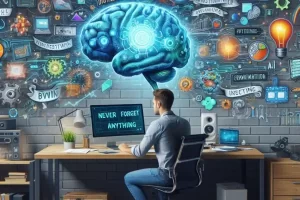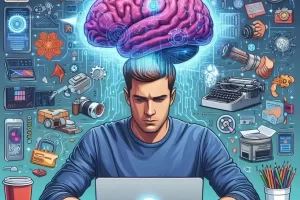Good thinking is the foundation of better decisions, better work, and a better life. But thinking is invisible — and often unstructured. That’s why most people repeat the same thoughts, miss their own patterns, and struggle to make progress. With a second brain, powered by artificial intelligence (AI), you can change that.
In this article, you’ll learn how to use your second brain to build stronger thinking habits, develop your mental clarity, and train your mind like a muscle — with AI as your thinking coach.
Why Thinking Needs a System
Thinking happens all the time — but without a system:
- You overthink instead of progressing
- You forget insights you’ve already had
- You let emotions or distractions cloud judgment
- You don’t build on your ideas — you start from scratch every time
A second brain gives your thoughts a home. AI gives them structure, feedback, and evolution.
When combined, they help you think:
- More clearly
- More critically
- More creatively
- More consistently
Define the Thinking Habits You Want to Build
First, clarify which thinking habits will improve your life or work. These might include:
- Reflective thinking: pausing to analyze past actions
- Critical thinking: questioning assumptions and biases
- First-principles thinking: breaking down problems to basics
- Systems thinking: seeing patterns, not just isolated events
- Optimistic thinking: training your brain to look for opportunity
- Meta-cognition: thinking about how you think
Ask AI:
“What thinking habits would benefit someone working in [your field]?”
“Based on my goals and journal entries, which thinking styles should I improve?”
This gives your second brain a growth target.
Set Up a Thinking Habits Tracker
In your second brain (Notion, Obsidian, or Tana), create a Thinking Habits Tracker that includes:
- The thinking habit you’re building
- Daily or weekly reflection questions
- Links to relevant notes or prompts
- Self-rating (e.g., 1–5 scale)
- Wins or examples from real life
Use AI to help you review:
“Summarize my last 7 thinking habit check-ins.”
“What patterns do you notice in how I evaluate my thinking?”
“Suggest ways I can improve my critical thinking this week.”
Capture Your Best Thinking in Real Time
When you have a useful insight, decision, question, or strategy — write it down. These are thinking moments worth saving.
Use:
- Voice notes → transcribed with Otter.ai
- Quick capture inboxes in Notion or Tana
- Daily journal with thinking tags (e.g., “strategic thinking,” “mental clarity”)
Then ask AI to help:
“Summarize this idea and connect it to related themes in my second brain.”
“What kind of thinking does this reflect: emotional, strategic, reflective, or reactive?”
This creates a thinking map of your mind.
Use AI to Challenge and Refine Your Thinking
AI becomes your thinking partner when you ask it to:
- Spot inconsistencies
- Suggest alternatives
- Play devil’s advocate
- Offer frameworks or analogies
- Turn vague thoughts into structured arguments
Prompt examples:
“Challenge my thinking on this decision.”
“What assumptions am I making that I haven’t tested?”
“Turn this journal entry into a first-principles breakdown.”
“What cognitive bias might be influencing this line of thought?”
This helps you think better, not just more.
Review and Reflect Regularly
Thinking habits are built through repetition and reflection.
Set weekly or monthly AI-assisted reviews to ask:
- “What thinking patterns dominated this week?”
- “Where did my thinking lead to strong results — or poor ones?”
- “Which journal entries reflect clear vs. unclear thinking?”
- “What did I learn about how I make decisions?”
AI can summarize your thoughts and surface insights — even when you don’t realize they’re there.
Create a Thinking Template Library
Save time by using or building templates for common thinking challenges:
- Decision template: Pros, cons, risks, values
- Reflection template: What happened, why, what to change
- Idea template: Core concept, examples, use cases
- Problem-solving template: Root cause, options, experiments
- Argument builder: Claim, support, counterpoint, conclusion
Use AI to:
“Apply the decision template to this career move I’m considering.”
“Turn my notes into a structured argument I can use in my next meeting.”
“What framework fits best for this challenge?”
This makes deep thinking more repeatable and accessible.
Use AI to Simulate Other Points of View
AI can act as:
- A mentor
- A skeptical client
- A curious learner
- A team member
- Your future self
Prompt examples:
“You’re my future self 2 years from now. What advice do you have about this decision?”
“Act as a client who disagrees with my pitch. What would you say?”
“Pretend you’re a beginner — what questions would you ask about my idea?”
This exercise helps you broaden your thinking and prepare for real-world challenges.
Real-Life Example: The Thinking-Focused Entrepreneu
Let’s say you’re building a product and leading a team.
Your second brain includes:
- Weekly reflections on leadership decisions
- A thinking habits tracker that highlights emotional reactions vs. rational analysis
- AI-powered summaries that surface blind spots and bias
- A “Mental Models” library linked to real project notes
- An end-of-week AI-generated report: “Your best thinking moments this week were strategic. You avoided bias in two major decisions. Consider applying systems thinking to your hiring process next.”
You don’t just get things done — you get better at how you think.
Final Thoughts: Think Better, Live Better
Your thoughts shape your life. But most people never train their thinking — they just repeat it.
With a second brain and AI, you now have:
- A place to capture your thinking
- A system to analyze and refine it
- A partner to challenge and improve it
- A process to grow from it
Better thinking isn’t just for philosophers or CEOs. It’s for anyone who wants to live and work with clarity, intention, and impact.
Start building your thinking system today. Capture your thoughts. Question them. Let AI make them sharper. And become the kind of thinker — and person — you aspire to be.




